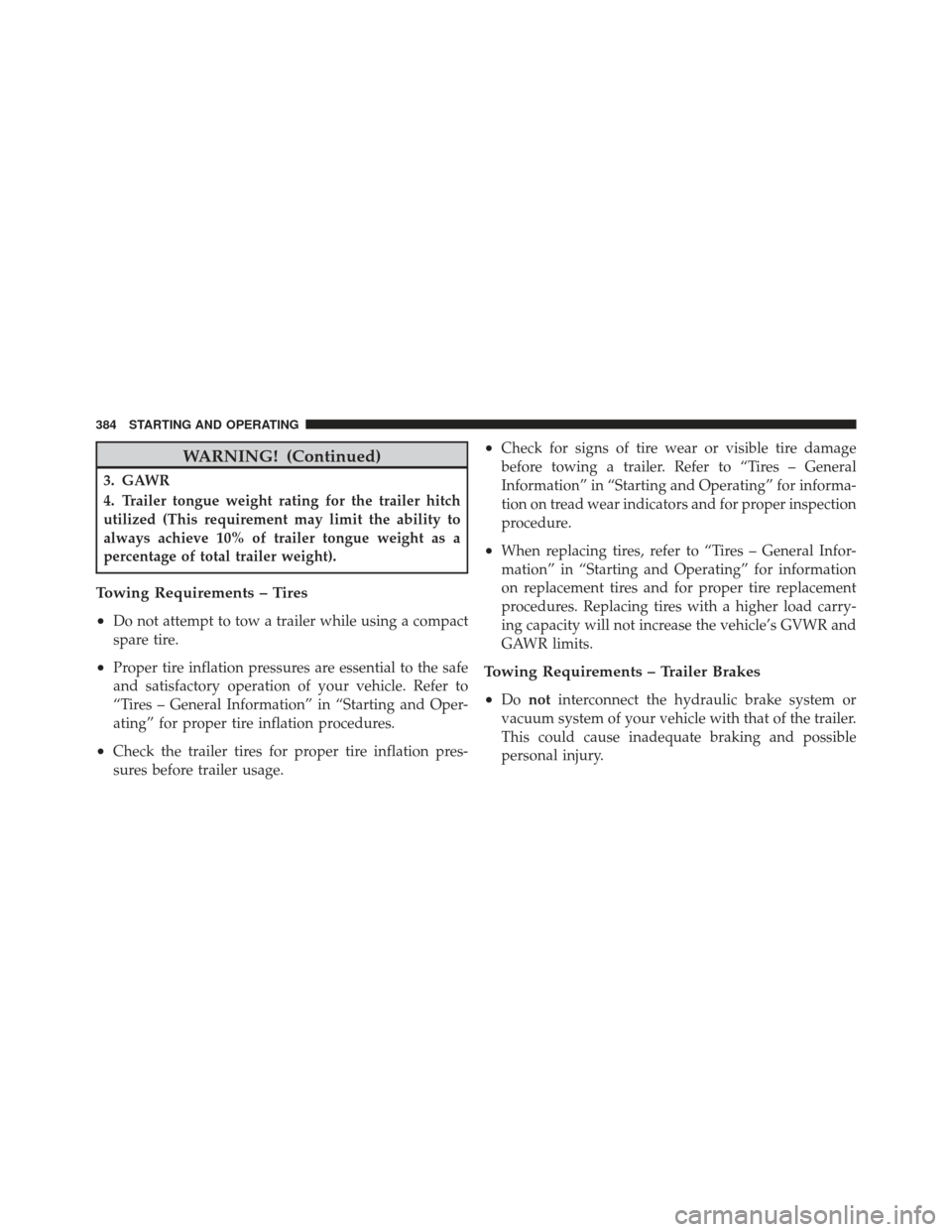Page 360 of 517

NOTE:
•The TPMS is not intended to replace normal tire care
and maintenance, or to provide warning of a tire
failure or condition.
•The TPMS should not be used as a tire pressure gauge
while adjusting your tire pressure.
•Driving on a significantly under-inflated tire causes
the tire to overheat and can lead to tire failure.
Under-inflation also reduces fuel efficiency and tire
tread life, and may affect the vehicle’s handling and
stopping ability.
•The TPMS is not a substitute for proper tire mainte-
nance, and it is the driver ’s responsibility to maintain
correct tire pressure using an accurate tire pressure
gauge, even if under-inflation has not reached the
level to trigger illumination of the “Tire Pressure
Monitoring Telltale Light.”
•Seasonal temperature changes will affect tire pressure,
and the TPMS will monitor the actual tire pressure in
the tire.
Base System
The Tire Pressure Monitor System (TPMS) uses wireless
technology with wheel rim mounted electronic sensors to
monitor tire pressure levels. Sensors, mounted to each
wheel as part of the valve stem, transmit tire pressure
readings to the Receiver Module.
NOTE:It is particularly important for you to check the
tire pressure in all of the tires on your vehicle monthly
and to maintain the proper pressure.
The TPMS consists of the following components:
•Receiver Module
•Four Tire Pressure Monitoring Sensors
•Tire Pressure Monitoring Telltale Light
358 STARTING AND OPERATING
Page 361 of 517

Tire Pressure Monitoring Low Pressure Warnings
The “Tire Pressure Monitoring Telltale Light” will
illuminate in the instrument cluster, a�LOW TIRE�
message will be displayed for a minimum of five
seconds and a chime will sound when tire pressure is low
in one or more of the four active road tires. Should this
occur, you should stop as soon as possible, check the
inflation pressure of each tire on your vehicle, and inflate
each tire to the vehicle’s recommended cold placard
pressure value. Once the system receives the updated tire
pressures, the system will automatically update and the
“Tire Pressure Monitoring Telltale Light” and �LOW
TIRE� message will turn off. The vehicle may need to be
driven for up to 20 minutes above 15 mph (24 km/h) in
order for the TPMS to receive this information.
Check TPMS Warning
The “Tire Pressure Monitoring Telltale Light” will flash
on and off for 75 seconds and then remain on solid when
a system fault is detected. The system fault will also sound a chime. If the ignition key is cycled, this sequence
will repeat, providing the system fault still exists. The
“Tire Pressure Monitoring Telltale Light” will turn off
when the fault condition no longer exists. A system fault
can occur due to any of the following:
1. Jamming due to electronic devices or driving next to
facilities emitting the same Radio Frequencies as the TPM
sensors.
2. Installing some form of aftermarket window tinting
that affects radio wave signals.
3. Lots of snow or ice around the wheels or wheel
housings.
4. Using tire chains on the vehicle.
5. Using wheels/tires not equipped with TPM sensors.
5
STARTING AND OPERATING 359
Page 386 of 517

WARNING! (Continued)
3. GAWR
4. Trailer tongue weight rating for the trailer hitch
utilized (This requirement may limit the ability to
always achieve 10% of trailer tongue weight as a
percentage of total trailer weight).
Towing Requirements – Tires
•
Do not attempt to tow a trailer while using a compact
spare tire.
•Proper tire inflation pressures are essential to the safe
and satisfactory operation of your vehicle. Refer to
“Tires – General Information” in “Starting and Oper-
ating” for proper tire inflation procedures.
•Check the trailer tires for proper tire inflation pres-
sures before trailer usage.
•Check for signs of tire wear or visible tire damage
before towing a trailer. Refer to “Tires – General
Information” in “Starting and Operating” for informa-
tion on tread wear indicators and for proper inspection
procedure.
•When replacing tires, refer to “Tires – General Infor-
mation” in “Starting and Operating” for information
on replacement tires and for proper tire replacement
procedures. Replacing tires with a higher load carry-
ing capacity will not increase the vehicle’s GVWR and
GAWR limits.
Towing Requirements – Trailer Brakes
•
Donot interconnect the hydraulic brake system or
vacuum system of your vehicle with that of the trailer.
This could cause inadequate braking and possible
personal injury.
384 STARTING AND OPERATING
Page 512 of 517

Tilt Steering Column..................... 172
Time Delay, Headlight .................... 163
Tip Start .............................. 305
Tire and Loading Information Placard ......... 340
Tire Identification Number (TIN) ............. 338
Tire Markings .......................... 334
Tire Safety Information .................... 334
Tires ............................ 85,344,491
Aging (Life of Tires) .................. 351
Air Pressure ........................ 344
Chains ............................ 354
Changing .......................... 394
Compact Spare ...................... 348
General Information .................. 344
High Speed ......................... 346
Inflation Pressures .................... 345
Jacking ............................ 394
Life of Tires ........................ 351
Load Capacity .................... 340,341Pressure Monitor System (TPMS)
......... 355
Pressure Warning Light ................ 212
Quality Grading ..................... 491
Radial ............................ 347
Replacement ........................ 352
Rotation ........................... 354
Safety .......................... 334,344
Sizes ............................. 336
Snow Tires ......................... 354
Spare Tire .......................... 394
Spinning ........................... 350
Tread Wear Indicators ................. 350
To Open Hood .......................... 159
Tongue Weight/Trailer Weight .............. 381
Tonneau Cover .......................... 91
Towing ............................... 377
24-Hour Towing Assistance ............. 128
Disabled Vehicle ..................... 411
Guide ............................. 380
510 INDEX
Page:
< prev 1-8 9-16 17-24